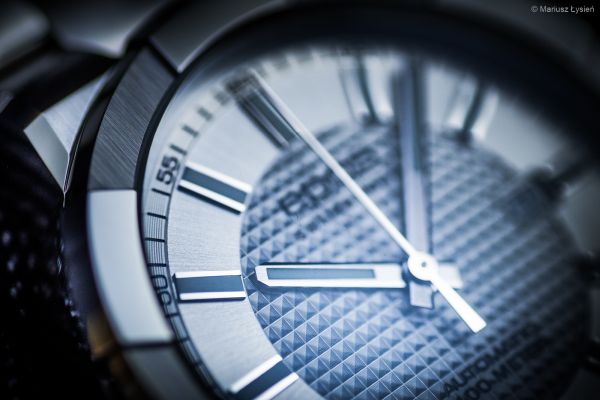Learn How to Measure Watch Case Dimensions to Choose the Perfect Model
If you're wondering how to choose the perfect watch that will match your wrist and outfit, you will surely pay attention to many factors such as color, material, or brand. However, one of the most important elements is its size. The size of the watch case significantly impacts its appearance and comfort of use. Therefore, it is crucial to choose the right case size that suits your needs and preferences. In this article, we will guide you on how to measure the watch case dimensions to find the perfect model. You will learn how to measure your wrist and discover the most popular watch sizes.
What Is a Watch Case? The Basics to Start With
Before we move on to measuring, it is essential to understand what exactly the watch case is. It is one of the most critical components of a watch, often determining its character and style. The watch case is simply the housing of the movement, protecting it from damage, moisture, and other harmful factors. When discussing case borders, we refer to the bezel or ring in the case of classic watches. On the other hand, sports watches like the Diver type use a bezel – made of aluminum, steel, or ceramic insert. It may be movable, rotating counterclockwise or in both directions, depending on the watch's functionality.
The watch case consists of several key elements that are worth knowing before making a purchase.
- Case frame – the outer part that gives watches their distinctive shape (most commonly round but can also be square, rectangular, or more complex in geometry).- Case lugs – protruding elements where the strap or bracelet is attached.
- Case back – the back part of the case, often screwed or snapped on, allowing access to the movement.
- Crystal – the transparent cover protecting the dial, made of mineral glass, sapphire, or acrylic.
- Crown – the component used to wind the movement or set the time.
Watch cases can be made from various materials such as stainless steel, titanium, gold, ceramic, and even plastics, which also impact their weight, durability, and price. Another important term to know is the watch profile, which refers to the internal construction of the case and the arrangement of movement components. However, in everyday language, it is often confused with case diameter.
Why Is the Watch Case Size Important?
Today, the market offers a variety of women's and men's watches in different sizes – from miniature to oversized, so it is essential to know the most popular case dimensions and how to measure them accurately. This way, you can choose the right model.
The size of the watch case is a crucial element to consider when selecting the right model. The case size has a significant impact on the appearance of the watch on your wrist and its comfort. A case that is too large may appear heavy and disproportionate to your wrist, while a case that is too small can be difficult to read and disrupt symmetry. That is why choosing the correct case size is so important.
Watch Dimensions Are Not Just About Width!
It is worth remembering that watch dimensions include not just the case width but also its thickness, which significantly affects comfort.
How to Measure Your Wrist Circumference?
To select the right watch case size, you must first measure your wrist circumference. You can do this using a tailor's measuring tape or a ruler with a piece of string. How to do it?
Measure at the spot where you usually wear your watch, just above the wrist bone. It is important to measure it accurately because even a slight difference in measurement can significantly impact the watch's appearance and comfort.
How to Measure the Watch Case? Step-By-Step Guide!
Do you want to check the watch case size? It is easier than it seems! Follow these simple steps:
1. Measuring the Case Diameter
Watch case diameter is the primary measurement defining watch size. To measure it:
- Place the watch on a flat surface,- Use calipers or a ruler with millimeter markings,
- Measure the distance from the left to the right edge of the case (excluding the crown),
- Record the result in millimeters.
2. Measuring the Case Thickness
The thickness of the watch case has a significant impact on how the watch looks on the wrist and how well it fits under a cuff:
- Place the watch on its side,- Measure the distance from the bottom of the case back to the top edge of the crystal,
- Pay attention to whether a domed crystal is exaggerating the measurement.
3. Measuring the Lug-to-Lug Distance
This is an important dimension that is often overlooked but is crucial for ensuring the watch fits comfortably on the wrist:
- Measure the distance between the extreme points of the opposite lugs of the case,- This dimension should be smaller than the width of the upper part of your wrist.
4. Measuring the Strap/Bracelet Width
This refers to the width of the strap or bracelet at the point where it connects to the case:
- Measure the distance between the inner edges of the lugs,- This dimension is essential if you plan to replace the strap with another one.
5. Measuring the Dial Size
The size of the watch dial is not the same as the case diameter:
- Measure the visible part of the dial without the case frame,- The diameter of the watch dial is always smaller than the case diameter.
Knowing all these dimensions will help you better assess whether a particular watch will look good on your wrist and whether it will be comfortable to wear.
Most Popular Watch Case Sizes – Which One to Choose?
If you're wondering what watch case size to choose, it's worth knowing the most popular sizes available on the market. This will give you a better idea of which size is best for you.
There are many watch case sizes, but the most common ones are:
- Medium size: from 38 to 42 mm (suitable for most men);- Large size: over 43 mm (suitable for men with larger wrists);
- Small size: below 37 mm (suitable for women and men with smaller wrists).
It's also worth noting that the size of a watch case can also depend on its style and type. For example, sports watches tend to have larger case sizes because they are designed to be more visible and easier to read during physical activity. Meanwhile, classic elegant watches may have smaller sizes as they are meant for everyday wear or formal occasions.
How to Choose a Watch as a Gift?
The size of the watch case is a crucial factor to consider when selecting the right model. To choose the appropriate size, you should measure your wrist circumference and take into account your preferences, as well as the style and type of the watch. This way, you can enjoy a comfortable and elegant watch that fits your wrist and outfit. If you are buying a watch as a gift, make sure to choose a size that suits the recipient.
If you’re unsure which model to pick, check out our ranking of the best Swiss watches, which stand as a class of their own. Enjoy!
See popular articles

Dlaczego zmieniamy czas na zimowy w zegarkach? Tłumaczymy mechanizm i historię zmiany czasu
Dwa razy w roku cofamy lub przesuwamy wskazówki zegara, ale rzadko zastanawiasz się, po co właściwie jest zmiana czasu i dlaczego wciąż jej przestrzegamy. To nie tylko kwestia tradycji – za tym zwyczajem stoi historia, decyzje polityczne i próba lepszego wykorzystania światła dziennego. Sprawdź, jak działa mechanizm przestawienia czasu, skąd się wziął i jakie ma znaczenie dziś.

Zegarki solarne - ranking ciekawych modeli i wszystko co warto wiedzieć przed zakupem
Zegarki solarne to nowoczesne połączenie stylu i praktyczności – zasilane światłem, niezawodne i przyjazne środowisku. Dzięki wbudowanym panelom solarnym nie wymagają regularnej wymiany baterii, co czyni je wyjątkowo wygodnymi w codziennym użytkowaniu i bardziej ekologicznymi. W naszym rankingu znajdziesz modele, które wyróżniają się nie tylko atrakcyjnym designem, ale również bogatą funkcjonalnością i imponującą trwałością, idealne dla wymagających użytkowników poszukujących zegarka na lata.

Jak zmienić czas na zimowy w Casio G Shock?
Zmiana czasu potrafi zamieszać – nie tylko w głowie, ale i na nadgarstku. Jeśli nosisz G-Shocka i chcesz szybko przestawić go na czas zimowy, nie musisz zagłębiać się w instrukcje ani zgadywać, który przycisk za co odpowiada. W tym poradniku znajdziesz konkretne wskazówki, proste kroki i sprawdzone triki, które pomogą Ci bez nerwów ustawić zegarek Casio G-Shock – niezależnie od modelu, który masz.

Jak dobrać biżuterię do zegarka? Zasady, inspiracje i gotowe triki stylizacyjne
Dobranie biżuterii do zegarka to nie tylko kwestia gustu, ale przede wszystkim umiejętność stworzenia spójnej, stylowej całości. Zegarek może być subtelnym tłem dla dodatków albo główną ozdobą, wokół której budujesz cały look. Sprawdź, jak łączyć metale, wybierać bransoletki i tworzyć zestawienia, które zawsze wyglądają elegancko i nowocześnie.

Jaki zegarek na 40 urodziny wybrać? TOP 5 wyborów
Czterdzieste urodziny to wyjątkowy moment – symboliczny etap życia, w którym zegarek może stać się nie tylko praktycznym dodatkiem, ale także wyrazem stylu, statusu i osobowości. Zegarek na 40 urodziny powinien podkreślać dojrzały gust, elegancję oraz indywidualność obdarowanego – kluczowe znaczenie ma jakość, prestiż marki oraz funkcjonalność dopasowana do codziennych aktywności Poniżej przedstawiamy TOP 5 zegarków męskich na 40 urodziny dostępnych w ofercie sklepu WestWatches – zapraszamy!

Jaki zegarek kupić na dzień chłopaka? TOP 6 propozycji od West Watches
Dzień Chłopaka to świetna okazja, aby podarować coś wyjątkowego – prezent, który będzie nie tylko praktyczny, ale i symboliczny. Zegarek to zawsze trafiony wybór – elegancki, funkcjonalny i trwały. Ważne jednak, by dopasować go do stylu oraz trybu życia obdarowywanego. Czy woli klasyczną elegancję, sportowy look, a może nowoczesne technologie? Poniżej znajdziesz sześć propozycji z oferty WestWatches.pl, które sprawdzą się jako idealny prezent.

Czym jest bezel zegarka? Wyjaśniamy jego zastosowanie i zalety
Bezel to detal, który często umyka uwadze, a w rzeczywistości decyduje o funkcjonalności, stylu i bezpieczeństwie zegarka. To właśnie ten pierścień sprawia, że czasomierz staje się czymś więcej niż tylko ozdobą na nadgarstku. Dowiedz się, co to jest bezel w zegarku, jak działa i do czego możesz go wykorzystać na co dzień.

Tachometr - co to jest i jaką funkcję pełni w zegarku?
Tachometr w zegarku to coś więcej niż ozdobna skala na tarczy – to praktyczne narzędzie, które pozwala w kilka sekund obliczyć średnią prędkość na wybranym dystansie. Choć dziś korzystasz z GPS-u, ta klasyczna funkcja nadal ma swój urok i znaczenie, łącząc precyzję z historią zegarmistrzostwa.

Bransoleta mesh - czym jest i do jakich stylizacji pasuje?
Jeśli szukasz dodatku, który połączy wygodę codziennego noszenia z elegancją biżuterii, bransoleta mesh może być strzałem w dziesiątkę. Ten charakterystyczny, mediolański splot od lat zdobywa uznanie zarówno wśród miłośników klasycznych zegarków, jak i fanów nowoczesnych smartwatchy. Zanim zdecydujesz się na zakup, sprawdź, co dokładnie oznacza ten typ bransolety, jakie są opinie użytkowników i w jakich stylizacjach sprawdza się najlepiej.












